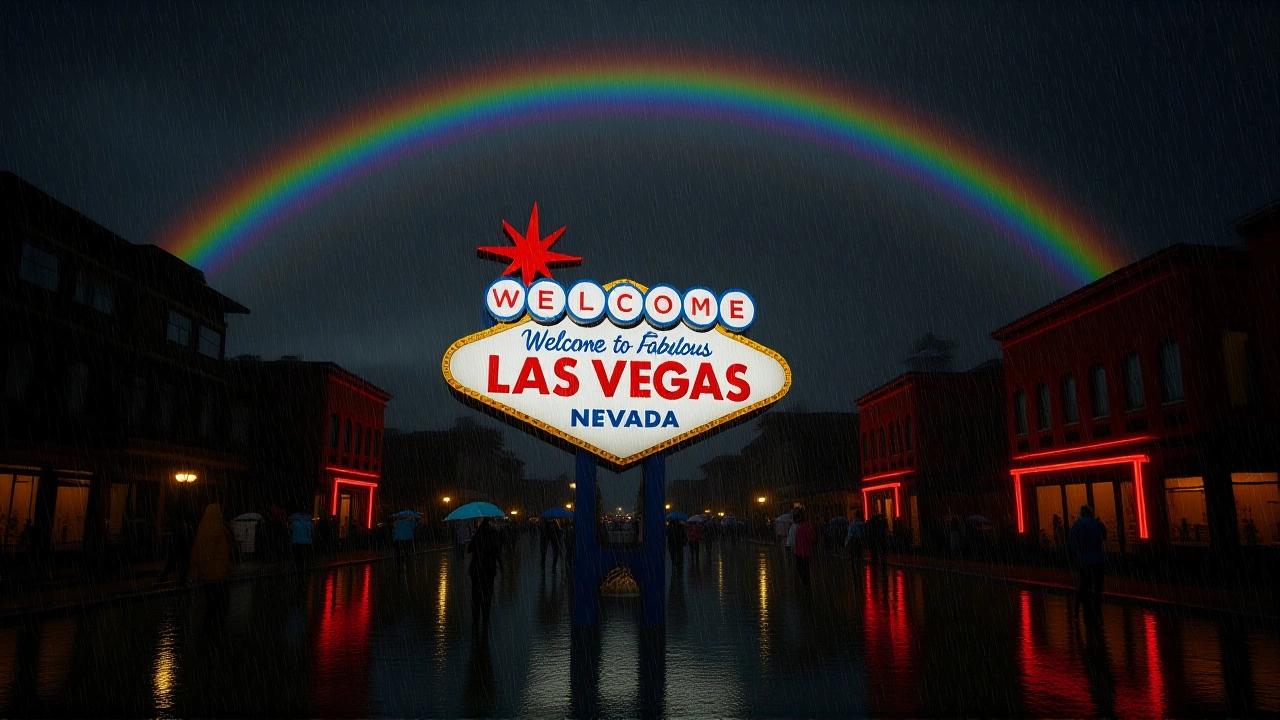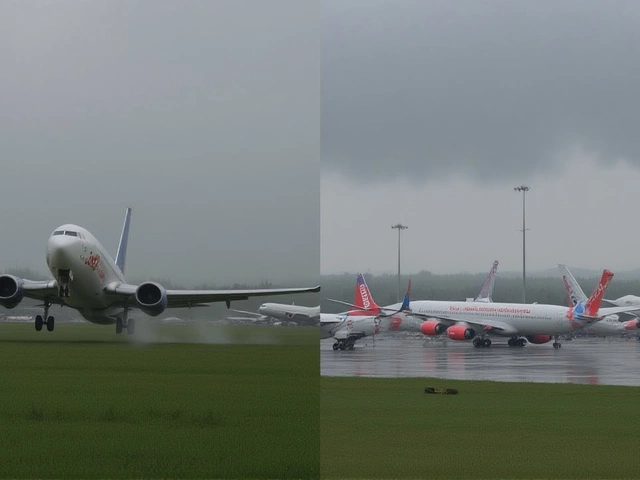On November 16, 2025, Las Vegas shattered a 61-year-old weather record, soaking the city with 0.65 inches of rain at Harry Reid International Airport—the wettest November 16 in recorded history. The deluge, which came exactly six days before the 2025 Formula 1 Las Vegas Grand PrixLas Vegas Strip, sent shockwaves through the motorsport world. Drivers, teams, and organizers now face a tense countdown: will the track stay dry, or will this year’s race become a muddy, treacherous spectacle?
Record Rainfall, Unexpected Timing
The previous record for rainfall on November 16—0.52 inches—stood since 1964. This year’s storm didn’t just break it; it smashed it by 25%. For a city that averages just 4.2 inches of rain annually, this was a meteorological anomaly. The National Weather Service issued flood warnings that lasted through Wednesday morning, prompting local authorities to clear drainage systems along the Las Vegas Strip and temporary barriers near the circuit’s pit lane.
By mid-November 2025, Las Vegas had already received 3.98 inches of precipitation—nearly half a full year’s worth in just 11 months. The valley’s climate, typically arid and sun-drenched, now feels increasingly unpredictable. "We’ve seen wetter Novembers before," said Dr. Elena Ruiz, a climatologist at the University of Nevada, Las Vegas. "But never this late in the month, and never with this intensity right before a global event like F1. It’s a warning sign."
Weather Forecasts: A Tale of Contradictions
Here’s the twist: while the city soaked up record rain on the 16th, every major forecast now points to a dry race weekend. The Las Vegas Review-Journal reported that the recent wet streak "appears to be in the rear view," with Saturday’s high expected at 64°F (17.8°C) and no precipitation in the 7-day outlook. Formula1.com predicted a 40% chance of rain on Thursday and Friday, but a 0% chance on race day. Williams F1 offered a middle ground: 30% chance across all three days, with temperatures hovering around 52–53°F.
Yet the uncertainty lingers. The National Weather Service initially warned of thunderstorms through Wednesday, and while those have since faded, the lingering moisture means the track surface could remain slick. "It’s not about whether it rains on Saturday," said veteran F1 engineer Marcus Delaney. "It’s about whether the track dried properly. Concrete and asphalt in desert cities don’t dry like they do in Europe. Water gets trapped in the pores. That’s where the danger is."

Drivers Fear the Worst
Drivers aren’t holding their breath. Multiple sources, including RaceFans.net, quote F1 pilots calling wet conditions on the Las Vegas circuit "nasty" and "not fun at all." The 3.8-mile street course, winding past casinos and neon-lit hotels, has one of the lowest grip levels of any track on the calendar. Add in the season’s coolest temperatures—nearly 10°C (50°F) at night—and the combination becomes a nightmare.
"You’re talking about cold tires on a surface that’s never meant to be wet," said a source close to the Mercedes team. "Even a light shower could turn it into a slide show. We’ve seen it in Monaco. But Monaco has drainage. Las Vegas? Not so much."
Compounding the issue: this year, practice sessions have been moved two hours earlier. That means Free Practice 1 and Free Practice 3 now occur at sunset, when humidity peaks and temperatures dip fastest. "It’s like racing in a fridge with a misty windshield," one driver reportedly told GPBlog.
Championship Implications
With only 58 points left to play for after the Las Vegas weekend, the 2025 title race is tighter than ever. Lando Norris of McLaren leads with 390 points, followed closely by teammate Oscar Piastri (366) and Max Verstappen of Red Bull (341). Norris holds a 24-point advantage—but he can’t clinch the title in Las Vegas. Even a win wouldn’t be enough. He needs to survive, not dominate.
"If it rains, it’s chaos," said a senior McLaren strategist. "And chaos favors the bold. Verstappen thrives in that. Piastri? He’s brilliant in wet conditions. Norris? He’s been cautious all year. That might cost him."

What Happens After the Checkered Flag?
The weather doesn’t end with the race. Sunday, November 23, is expected to be sunny with a high of 65°F. Monday and Tuesday will hover around 63–64°F—perfect for post-race parties and fan events. But the long-term question remains: is Las Vegas becoming a wetter city? The 2025 season marks the third consecutive year the valley has exceeded its average rainfall by mid-November. Climate scientists are watching closely.
"This isn’t one storm," said Dr. Ruiz. "It’s a pattern. And if F1 keeps coming here, they’ll need to plan for more than just heat. They’ll need to plan for floods, delays, and unpredictable track conditions. This race is becoming a climate stress test."
Frequently Asked Questions
Why is the Las Vegas F1 track particularly dangerous in wet conditions?
The Las Vegas Strip circuit is built on concrete and asphalt surfaces that weren’t designed for racing, let alone rain. Unlike purpose-built tracks, it lacks aggressive drainage, and its low-grip surface—meant for high-speed straights—becomes dangerously slick when damp. Combined with nighttime temperatures near 50°F, tire temperatures struggle to reach optimal operating range, increasing the risk of aquaplaning and loss of control.
Can Lando Norris win the championship in Las Vegas?
No. Even if Norris wins the race, he cannot clinch the 2025 title in Las Vegas. He leads by 24 points over Oscar Piastri, but with only 58 points remaining across the final two races (Las Vegas and Abu Dhabi), he needs at least one more podium finish after this weekend to mathematically secure the championship. A win here would put him in a strong position, but not a guaranteed one.
Why did the National Weather Service issue flood warnings if rain is gone by race day?
The record rainfall on November 16 overwhelmed local drainage systems, prompting emergency responses. Though the storm passed, residual moisture remained in the soil and infrastructure. The warnings were lifted by Wednesday because the immediate threat of flash flooding ended, but the lingering dampness is still a concern for track drying. It’s not about new rain—it’s about what’s still soaked beneath the surface.
How does this year’s weather compare to the 2024 Las Vegas Grand Prix?
The 2024 race featured clear skies and cool but dry conditions, with temperatures around 60–68°F and no precipitation. George Russell’s Mercedes 1-2 finish was a textbook example of clean, strategic racing. This year, the contrast couldn’t be starker: record rainfall just days before, uncertainty over track conditions, and colder nights. What was a precision event in 2024 could become a gamble in 2025.
What’s the significance of moving practice sessions earlier in the day?
Moving FP1 and FP3 to earlier slots means teams now run during sunset—when temperatures drop fastest and humidity rises. This creates a narrow window for tire warm-up and setup optimization. In dry conditions, it’s manageable. In damp ones, it’s a nightmare. Teams have less time to adapt before qualifying, and data from these sessions becomes less reliable. It’s a logistical headache with safety implications.
Is this a sign that Las Vegas might stop hosting F1?
Not immediately. The race is a massive economic driver, generating over $1 billion annually for the city. But climate experts warn that if extreme weather becomes routine, organizers may be forced to reconsider timing—perhaps moving the race to October or March. The 2025 event is a stress test. If the track floods again next year, or if delays become common, F1’s long-term future in Las Vegas could be in jeopardy.




